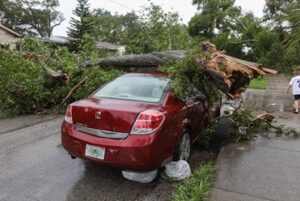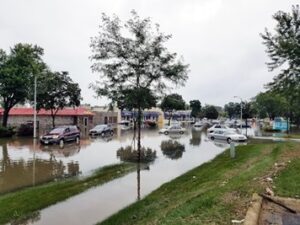
Summer storms can be powerful and unpredictable, leaving behind a trail of damage. While we often focus on protecting our homes during severe weather, it’s essential not to overlook our vehicles. From hail damage to flooding, summer weather can wreak havoc on cars, leaving owners wondering what steps to take next. In this guide, Cars Protection Plus discusses the necessary steps to take if your car suffers summer weather damage, helping you navigate the aftermath with confidence.
Assess the Damage
After a summer storm, it’s crucial to thoroughly assess the damage inflicted upon your vehicle. One of the most common types of damage resulting from summer storms is hail damage. Hailstones can range in size from small pellets to large, destructive chunks, and they can cause significant dents and dings on the body of your car. Additionally, hailstones can shatter windshields and windows, leading to cracked or broken glass.
When inspecting your vehicle for hail damage, carefully examine the exterior for any signs of dents or dimples. These may appear as small depressions or indentations on the surface of the car. Pay close attention to areas such as the hood, roof, trunk, and side panels, as these are the most susceptible to hail damage due to their flat surfaces. Inspect the windshield and windows for cracks or chips, as even small cracks can compromise the structural integrity of the glass and impair visibility while driving.
In addition to hail, summer storms can also cause water damage to vehicles, particularly if they are caught in a flood. Floodwaters can seep into the interior of the car, saturating carpets, upholstery, and electrical components. This can lead to mold growth, corrosion, and electrical issues if not addressed promptly.
When checking for flooding, look for signs of moisture or dampness inside the vehicle. Inspect the floorboards, carpeting, and upholstery for water stains, discoloration, or a musty odor, which are all indications of water intrusion. Check the trunk and storage compartments for pooling water or dampness, as well as the engine compartment for signs of water damage to electrical components.
Once you’ve assessed the damage to your vehicle, it’s essential to determine whether it’s covered under your car warranty.
If your car warranty does not cover the damage, you may still be able to file a claim with your insurance provider. Comprehensive auto insurance typically covers damage caused by natural disasters, including hailstorms and floods, so it’s essential to contact your insurance company as soon as possible to begin the claims process. Provide them with detailed information about the damage to your vehicle, including any photos or documentation you’ve gathered during your assessment.
Contact Your Warranty or Insurance Provider
Once you’ve evaluated the damage, reach out to your insurance or warranty provider to report the incident. Furnish them with comprehensive details about the damage sustained by your vehicle and any pertinent photos you’ve captured. Depending on your coverage, your insurance provider might cover the expenses for repairs, making it imperative to initiate the claims process promptly.
Document the Damage
Before beginning any repairs, it’s essential to document the damage thoroughly. Take photos of the exterior and interior of your vehicle from multiple angles, making sure to capture any dents, scratches, or water damage. This documentation will serve as evidence for your insurance claim and can help ensure that you receive proper compensation for repairs.

Seek Professional Repairs
While some minor damage may be manageable on your own, it’s often best to seek professional repairs, especially for significant issues like hail damage or flooding. Look for reputable auto body shops in your area that specialize in storm damage repairs. Be sure to get estimates from multiple shops and choose one that offers quality service at a reasonable price.
Address Water Damage Promptly
If your car has been flooded during a summer storm, it’s crucial to address water damage promptly to prevent further issues. Contact a professional auto detailer or mechanic who specializes in water damage restoration. They can assess the extent of the damage and take steps to dry out the interior of your vehicle, prevent mold growth, and salvage any affected components.
Protect Your Vehicle from Future Damage
Once your car has been repaired, take steps to protect it from future summer weather damage. Consider investing in a car cover or parking in a covered garage during storms to minimize exposure to hail and other elements. Regularly inspect your vehicle for signs of damage and address any issues promptly to prevent them from worsening over time.
Conclusion
Summer weather can pose significant risks to vehicles, from hail damage to flooding. If your car suffers damage during a summer storm, it’s essential to take prompt action to assess the damage, contact your insurance provider, and seek professional repairs. By following these steps and taking proactive measures to protect your vehicle, you can navigate the aftermath of summer weather damage with confidence and ensure that your car stays safe and roadworthy for years to come.